

Une xylothèque est une collection de bois ou encore le lieu où celle-ci est conservée. Celle du @Le_Museum abrite ces échantillons de bois venant de Chine, mais aussi près de 12 000 échantillons de bois de formats et de gabarits va. From the glory of beautiful woodland to the detail of glass slide wood collection in #DBNherbarium , there are lots of ways to study woodlands. The Xylothek ~ A Wooden Library. Rows (and Rose) of Wood! This summer the BRIT Herbarium began investigating and curating a unique collection of specimens comprised mostly from the Houston Public Museum (HPM) (now known as the Houston Museum of Natural History) collection acquired in 2001.

How Kew’s wood experts solve crimes. Chronicles of the Rings: What Trees Tell Us. Those tree rings also showed that during six decades, from 1568 until 1634, there was, because of natural climate variation, six decades of expansion of the subtropics, which pushed desert climates north.
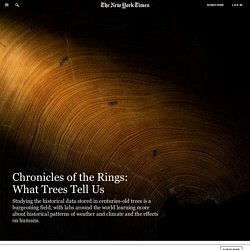
Because of expanding zones of hot and dry weather, the Ottoman Empire began to decline, the Ming dynasty collapsed and the Jamestown colony in Virginia was abandoned, suggesting, Dr. Trouet said, they were in part at least, climate-related. “The way society handles a drought politically is also part of the picture,” she said. Other sources — lake sediments; ice core samples; coral; the otolith, or ear bone, of fish; and even the shells from living and long dead geoducks, a large bivalve with a snakelike appendage — add to the broader picture.
“We have divers sucking up ancient geoducks off the ocean floor,” said Bryan Black, a professor of dendrochronology who also specializes in marine organisms. Even the stars give up some of their secrets to trees. Growth rings of Brazil nut trees (Bertholletia excelsa) as a living record of historical human disturbance in Central Amazonia. Abstract The Brazil nut tree (Bertholletia excelsa) is an iconic and economically valuable species that dominates vast swathes of the Amazon Basin.
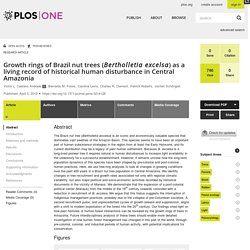
This species seems to have been an important part of human subsistence strategies in the region from at least the Early Holocene, and its current distribution may be a legacy of past human settlement. Because B. excelsa is a long-lived pioneer tree it requires natural or human disturbances to increase light availability in the understory for a successful establishment. However, it remains unclear how the long-term population dynamics of this species have been shaped by pre-colonial and post-colonial human practices. Here, we use tree-ring analyses to look at changes in growing conditions over the past 400 years in a Brazil nut tree population in Central Amazonia. Editor: Arun Jyoti Nath, Assam University, INDIA Received: August 24, 2018; Accepted: March 7, 2019; Published: April 3, 2019 Copyright: © 2019 Caetano Andrade et al. Introduction. Kew’s tree library leads hi-tech war on illegal logging. The wooden blinds that lie crumpled in Peter Gasson’s laboratory in Kew Gardens are chipped and forlorn-looking.

Their manufacturers had claimed they were made of pine but customs officers were wary. And their suspicions were well-founded. Gasson, Kew’s research leader on wood and timber, found the blinds were not made of pine but ramin. “All ramin trees, which grow in south-east Asia, are endangered and trade in their wood is illegal,” said Gasson. “On this occasion, we got lucky and stopped people profiting from this trade.” But elsewhere, illegal logging threatens to overwhelm the timber trade. The trouble with travelling tree rings. Growing interest in wood libraries sees tree lovers converge at local branches. Posted A humble timber renaissance is taking place worldwide, with proponents seeking to reconnect with the natural world.

Buildings made from natural timbers have been springing up across the country as part of wood encouragement policies. And now somewhat forgotten wood libraries — known as xylaria — are also drawing in new visitors. Wood lovers get a wide sample of local and exotic timbers in the stoic shelves of the collection. Springtime for natural materials. Wood collection. The wood collection was initially assembled for researching and teaching wood science, within forestry education in Australia, following the establishment of the Australian Forestry School in Canberra (1927).
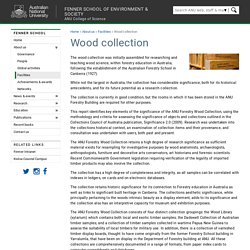
While not the largest in Australia, the collection has considerable significance, both for its historical antecedents, and for its future potential as a research collection. The collection is currently in good condition, but the rooms in which it has been stored in the ANU Forestry Building are required for other purposes. This report identifies key elements of the significance of the ANU Forestry Wood Collection, using the methodology and criteria for assessing the significance of objects and collections outlined in the Collections Council of Australia publication, Significance 2.0 (2009). Tree Rings.
Index Xylariorum. International Wood Collectors Society. 52 Types of Wood and the Trees They Come From. Pacific Forestry Centre’s Forest Pathology Herbarium. The Forest Pathology Herbarium at the Pacific Forestry Centre is an internationally recognized collection of over 35,300 preserved and catalogued forest fungi and disease specimens, representing over 3,000 different fungal species, including over 140 type specimens.

Abbreviated in the Index Herbariorum, a catalogue of the world’s herbaria, as DAVFP (Department of Agriculture, Victoria, Forest Pathology), the herbarium has existed through a number of departmental changes since its establishment in 1940. Voucher collections are deposited in DAVFP for permanent documentation of new species and disease distribution records in British Columbia and Yukon. DAVFP specimens are also loaned for research purposes to scientists all over the world. Permanent displays adjacent to the specimen storage area are a favourite stop for visitors touring the Pacific Forestry Centre. Grad student curatorial project: U-M Herbarium begins digitizing its wood collection. What rhymes with herbarium?
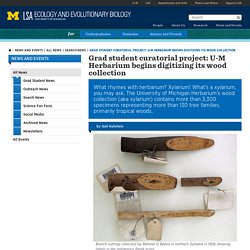
Xylarium! What’s a xylarium, you may ask. The University of Michigan Herbarium’s wood collection (aka xylarium) contains more than 3,300 specimens representing more than 130 tree families, primarily tropical woods. Kew Mobile Museum: Wood turning collection. KBD: Kew Bibliographic Databases: Detailed results. Bailey-Wetmore Wood Collection. Sonderausstellung 1998. Une collection de bois quasi unique au monde / La xylothèque du Cirad, une renommée mondiale / Quiz et diaporamas / La médiathèque - Innovons ensemble pour les forêts tropicales de demain - Cirad. Forest Products Laboratory - USDA Forest Service. The mission of the Center is to combine state-of-the-art knowledge and techniques in botany and wood anatomy in the search for new approaches and improvements to wood identification and to accumulate and make known information on the anatomical and other characteristics of woods that may affect their utilization potential.
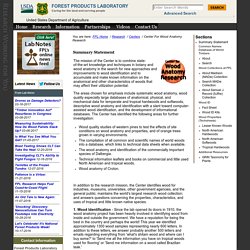
The areas chosen for emphasis include systematic wood anatomy, wood quality especially large databases of anatomical, physical, and mechanical data for temperate and tropical hardwoods and softwoods, descriptive wood anatomy and identification with a slant toward computer-assisted wood identification, and the development of informational databases. The Center has identified the following areas for further investigation: Wood quality studies of western pines to test the effects of site conditions on wood anatomy and properties, and of orange trees grown in varying environments. 1. 2. NorWood: a gene expression resource for evo-devo studies of conifer wood development - Jokipii-Lukkari - 2017 - New Phytologist. Talarico Hardwoods - Highly Figured Exotic Lumber. VENETIAN OAK ------ Own a piece of history!
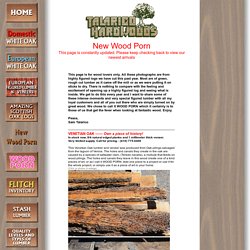
In stock now, 8/4 natural edged planks and 1 millimeter thick veneer. Very limited supply. Call for pricing. - (610) 775-0400. Romeyn B. Hough. The Woodbook - TASCHEN Books. Forrest’s Rhododendron Giant – Botanics Stories. Plant Collector George Forrest (1873-1932) introduced over 300 new rhododendron species to Britain but one in particular dwarfed all of these, Rhododendron protistum, which is represented in our collection by a large slice of tree trunk, felled by Forrest and his collectors in 1931 – it may even be our largest herbarium specimen? The slice of tree trunk – just over 65cm at its widest point.
Forrest referred to his find as Rhododendron giganteum – an appropriate name! Wooden veneers - new acquisition for timber collection @World_Museum #BotanicMonday #EconomicBotany #identification. Wood Collection / Smithsonian. Almost since its inception, the Smithsonian Institution has acquired botanical collections for scientific study. In the 1960s William L. Stern, then Chairman of the Department of Botany, played an important role in reorganizing and promoting the growth of what is now the Wood Collection of the Smithsonian's National Museum of Natural History. In 1960 the wood collections of the Division of Agriculture and Wood Products of the Smithsonian's Museum of History and Technology (now the National Museum of American History) were transferred to the Department of Botany.
These collections formed the basis for a Division of Woods, the name of which was changed to Division of Plant Anatomy in 1963. Today the Wood Collection contains ca. 42,500 specimens representing almost 3000 genera. Xylarium: Delaware State. The word “xylem” is derived from classical Greek ξυλον, xylon, “wood,” and indeed the best known xylem tissue is wood. A xylarium is a collection of authenticated wood specimens that is well-curated and accessible to the scientific community. The Peiffer Xylarium is unique among wood collections because it includes specimens that have their leaves, fruit, and scientific and common names lasered into the surface of the wood. The Peiffer Xylarium, established in 2006, is a unique, fledgling collection when compared to about one million xylarium specimens in worldwide collections: The collection began with 117 specimens catalogued in the Peiffer Xylarium.
These vary in size from ½´´ to 3´´ wide, ½´´ to 7´´ long, and 1/16´´ to ½´´ thick. Wood Collection: Kew. Oxford: Xylarium. Kerala Forest Xylarium. Xylarium is a collection of well-curated authenticated wood specimens. It is mainly intended to display collection of wood specimens for scientific research, teaching, environmental education and other programmes. The word ‘xylarium’ has been originated from Greek word ‘xylon’ meaning ‘wood’ and is used as ‘wood collection with proven and certified accuracy’. Wood collections may seem to be primarily of interest to wood anatomists, botanists and foresters, but they hold specimens and information applicable to many other fields such as antiques, furniture restoration, forensics, history, ecology, palaeontology, archaeology, conservation biology and climate change etc. As a service to the wood anatomical community, these collections will be of great use in wood anatomical studies, wood identification etc.
The scientists contributed to the collection and enrichment of xylarium in KFRI are: Drs. Xylarium - RISH, Kyoto University. Overview This Xylarium was founded in 1980, taking advantage of the registration of Index Xylariorum, International Wood Collections of the World, the code address of which is KYOw in 1978. The collection of wood samples was started in 1944 when The Wood Research Institute was established and totals now about 15 015 samples which contain 3 617 species, 1 131 genera, 172 families. Science & Conservation At Kew. Wood Science & Engineering. Inside Wood - Welcome. Microscopic Wood Anatomy. Wood anatomical diversity results from force of habit, and shifts in habitat - AoBBlog. Plant functional traits constitute responses to a complex evolutionary reciprocality between plants and the environment.
Wood anatomy varies between shrubs and trees, and between wet and dry habitats, but a question remains as to the degree to which growth habit and habitat shape and are in turn shaped by wood structure. Using phylogenetic comparative methods, Arévalo et al. tested for contingent evolution of wood anatomy, habit, and habitat in the mega-diverse angiosperm genus Croton (Euphorbiaceae), which possesses a growth habit manifesting in most species as persistently woody shrubs and small to large trees.
Vol20no1. Wood panels from the Japanese xylarium. Our mysterious treasure from Japan is restored. Spring has finally arrived at Kew. The sheets of colourful bulbs are a welcome reminder that we'll soon see the Japanese cherries flowering in the Gardens. This year, we also have our own spring display of flowers and fruits in the Economic Botany Collection. This follows the return of our Japanese xylarium (that's an old term for a wood collection) from conservation.
The panels in our collection are an intriguing combination of Japanese art and craft and a western approach to plant anatomy and botanical names. It includes 26 wooden panels, each made from the wood and bark of a different tree species and painted with the foliage, fruits and flowers of that species. Most items in Kew's Economic Botany Collection are very well documented, but so far we have not been able to find out exactly when these panels arrived at Kew. When they arrived, the Japanese panels were covered in a thick layer of grey dust. Following conservation, our Japanese panels glow with colour.